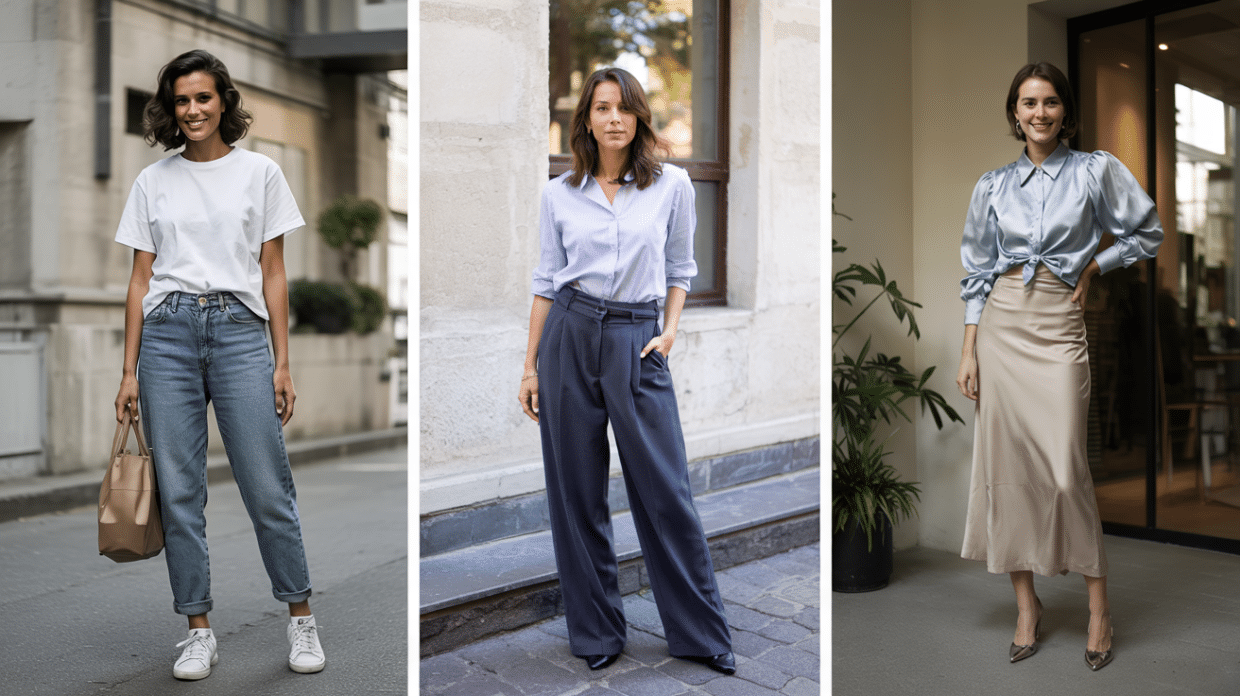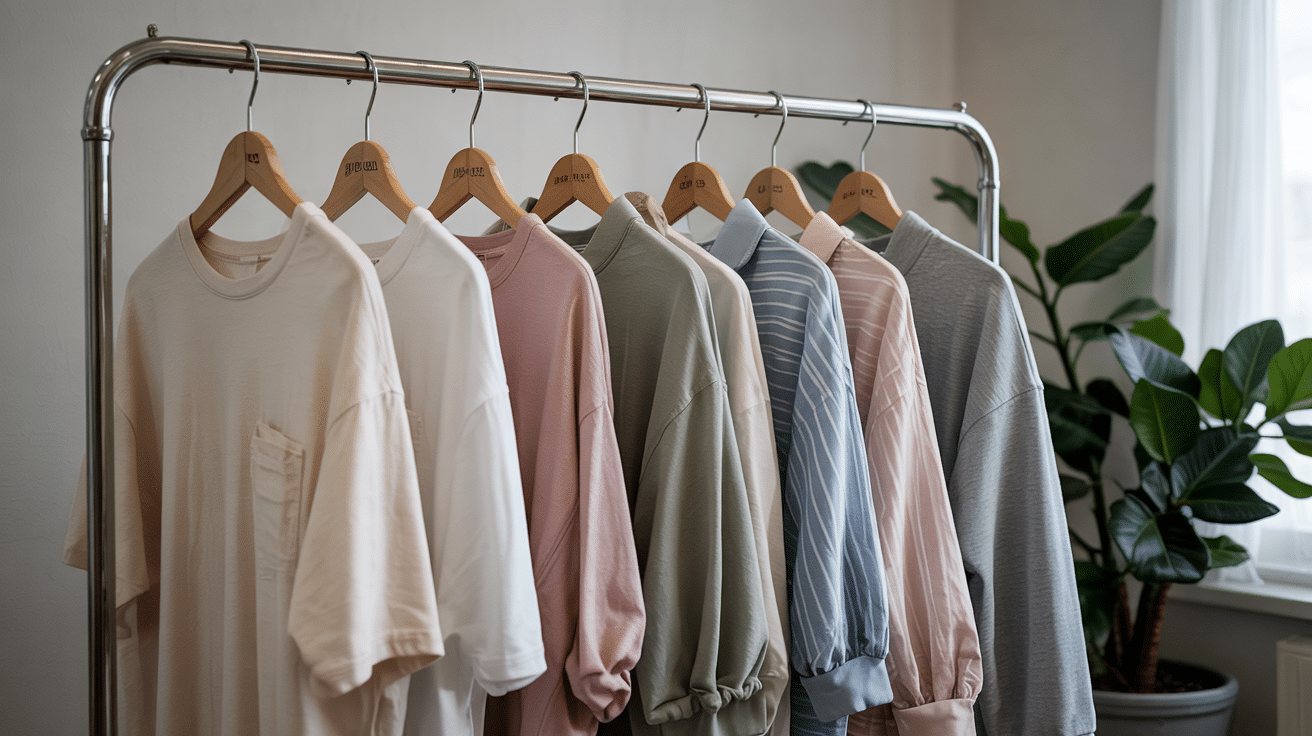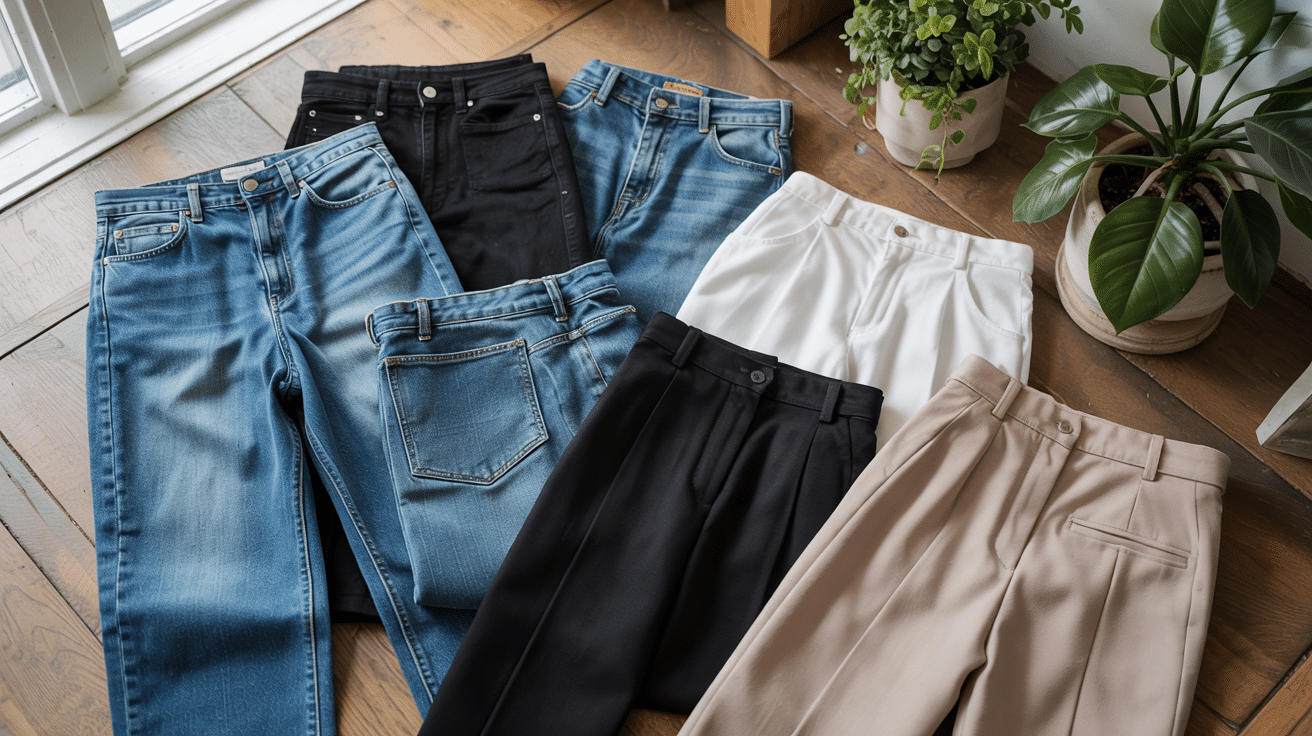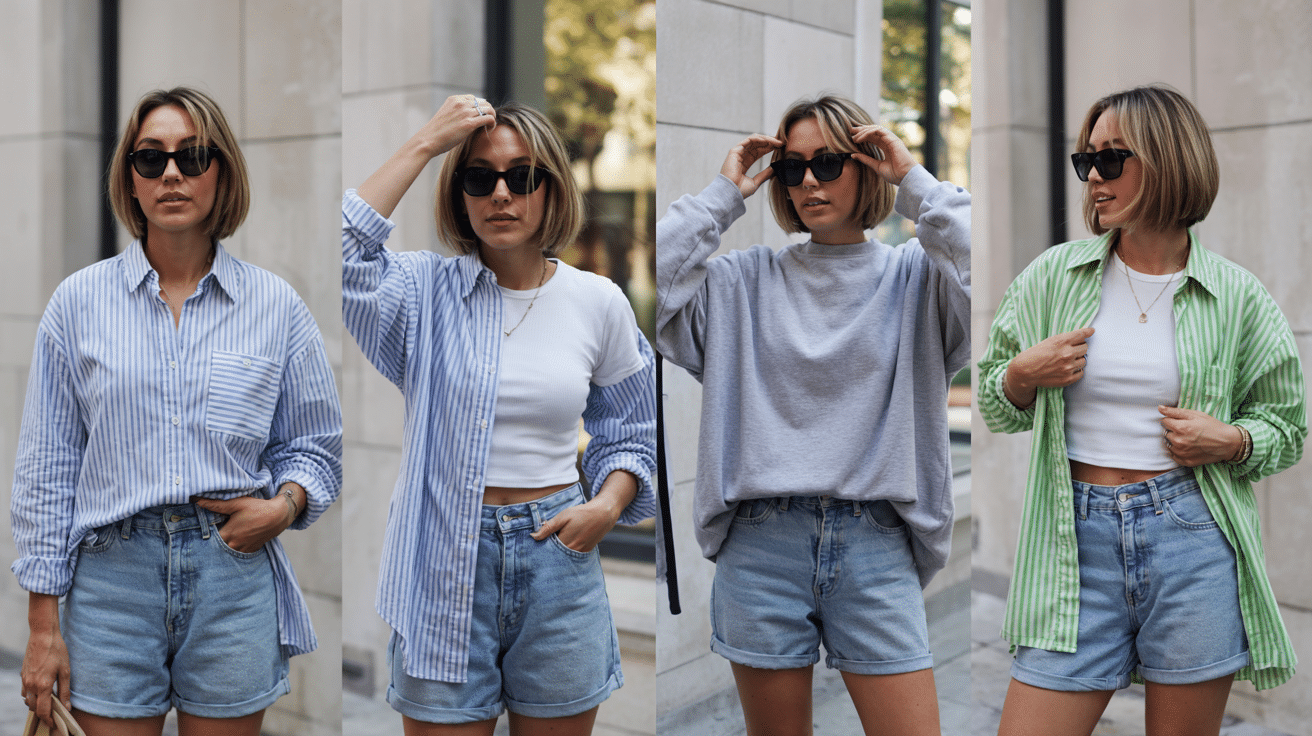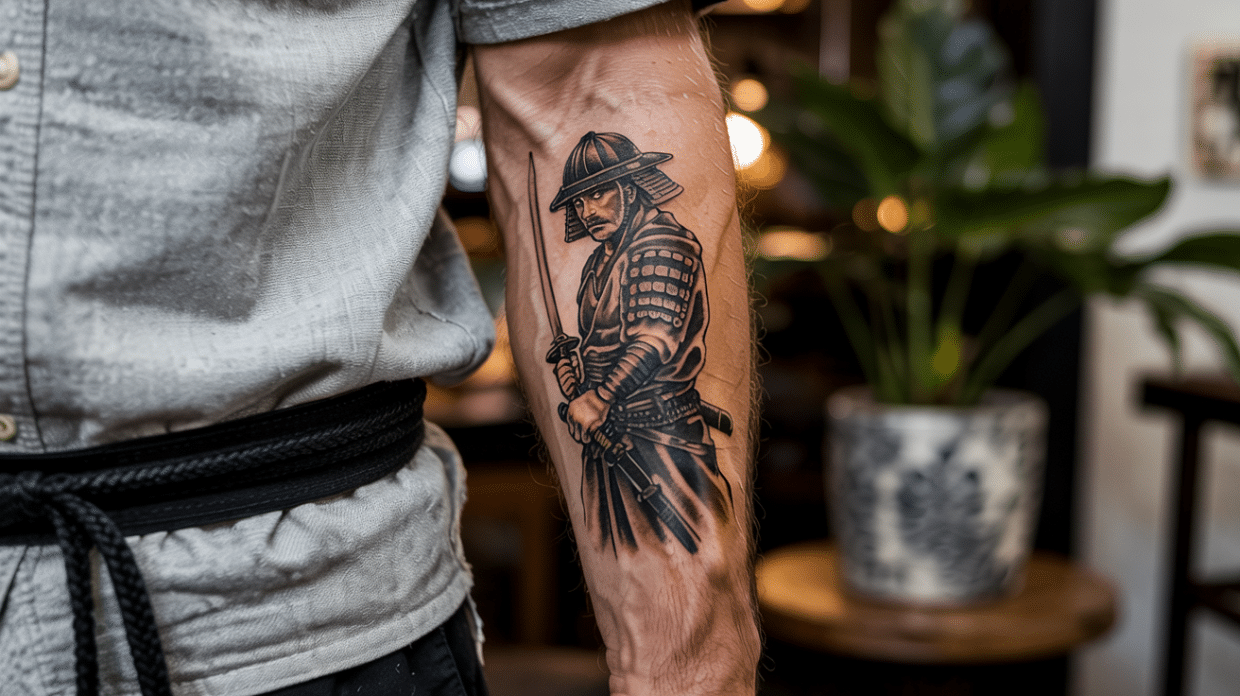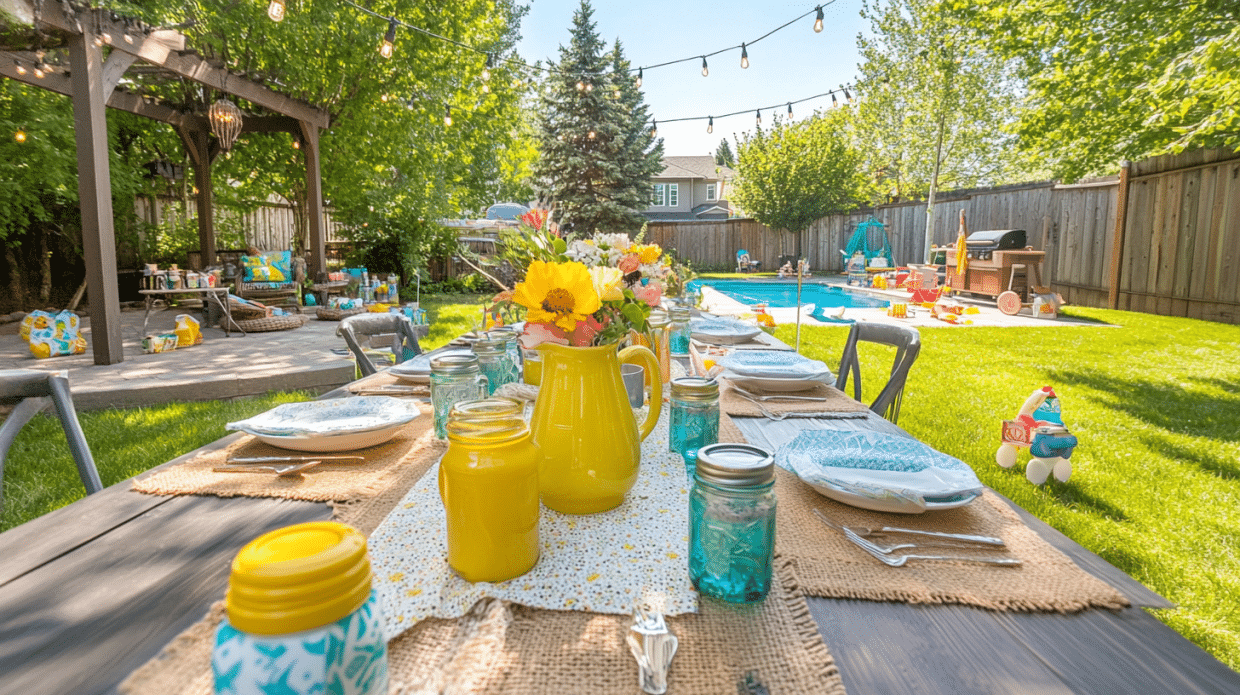Have you ever stood in front of the mirror, feeling like your outfit needed a little something more?
The French Tuck might be the answer you’re looking for. It’s a simple way to add shape and style without overthinking it.
In this blog, you’ll learn what the French Tuck is and why it works so well. You’ll find out which tops and bottoms make it easier.
I’ll guide you through different ways to tuck, depending on the style of your clothes.
You’ll also get tips for adjusting the tuck to fit your body and avoid common mistakes.
By the end, you’ll feel ready to use the French Tuck to make your outfits feel more pulled together and natural.
Curious about how this fits into everyday style? Read here: What Is a French Tuck?
What You Need for a French Tuck
To pull off a French Tuck, you need a loose or longer top and bottoms with a mid to high rise. Choosing soft, lightweight fabrics and well-fitting pants or skirts makes the tuck sit more naturally.
1. Tops for the French Tuck
When picking a top for the French Tuck, you want something with a bit of extra length.
Shirts that hit below your waist or cover part of your hips are the easiest to style.
Loose t-shirts, oversized button-downs, and cozy sweatshirts work really well. The way the fabric falls makes a big difference.
Lighter materials like cotton, linen, and soft blends let you shape the tuck without feeling bulky.
If your top is made of a heavier fabric like a thick sweatshirt, you can still make it work.
You just might need to tuck a smaller section to keep the outfit balanced and relaxed. A top that moves easily will help the tuck look natural and clean.
2. Bottoms for the French Tuck
The right bottoms help your French Tuck look neat and stay in place.
Mid-rise and high-rise pants are the best choices because they give the fabric something to hold onto.
Jeans, trousers, and skirts that sit at or just above your waist help create a smooth line from your top to your legs.
If you wear bottoms that sit too low, the tuck can look messy and break up your outfit’s shape.
Choosing structured pants or skirts can also make a big difference, giving your outfit a little more support without feeling tight.
Stretchy waistbands are helpful too, especially if you plan to adjust the tuck a few times during the day.
Instructions for Different Tuck Styles
There’s no one way to do a French Tuck. Different tops and fabrics need a slightly different touch.
Here’s how you can shape your tuck based on what you’re wearing.
1. Full French Tuck
For the full French Tuck, start by buttoning your shirt to the point where it meets the top of your pants or skirt.
Take the middle front part of the shirt and tuck it into your waistband. Cross the fabric slightly over your belly button for a smooth look.
Use your hands to gently pull and shape the fabric so it sits flat without extra bunching.
If the shirt feels too tight, loosen the tuck just a little until it looks easy and natural. This style works best with button-down shirts, lightweight blouses, or flowy tops.
2. T-shirt French Tuck
When working with a t-shirt, you want to keep things simple. Grab the center front of your shirt and tuck it lightly into the front of your pants or skirt.
Let the fabric relax as it moves toward the sides and back, leaving those areas untucked. This creates a soft curve that shapes your body without feeling stiff. Use your hands to smooth the fabric so it falls nicely without pulling.
A French tuck t-shirt is perfect for casual looks and adds a little structure to an easygoing outfit.
3. Oversized Sweatshirt Corner Tuck
Bulkier tops like oversized sweatshirts or sweaters need a different touch.
Instead of tucking across the entire front, pick one side near your hip and tuck just that small corner into your waistband.
Let the rest of the sweatshirt drape loosely across your body. This gives you some shape without forcing heavy fabric into a tight spot.
Make sure the tuck feels light and the fabric moves easily when you sit or walk.
A corner tuck helps bigger tops feel less overwhelming while still showing a bit of your shape.
4. Mini French Tuck
The mini French Tuck is a gentle way to shape shorter tops. You only need to tuck a small piece of fabric into your pants or skirt—just enough to show your waist without losing the flow of your outfit.
This style is good for tops that barely reach the waistband or for outfits where you want to keep things extra relaxed.
Keep the tuck light, and smooth out the sides so the look stays soft and clean.
A mini tuck works well when you want just a hint of structure without changing how the shirt fits your body.
Styling Tips for Success
Getting the French Tuck right is all about small adjustments. Little changes in how much fabric you tuck or pull out can make a big difference.
Paying attention to the fit of your clothes and the weight of your fabric helps, too. These easy tips will guide you to make the tuck look natural, comfortable, and shaped to your body.
How to Adjust the “Poof”
After you tuck, gently pull a little fabric back out. You want it to look soft and natural.
If the fabric bunches too much, smooth it down with your hands. Keep the tuck neat but not stiff.
Avoiding Common Styling Mistakes
Avoid using very heavy or stiff fabrics. Also, skip low-rise pants, as they break up the smooth line you want to create.
Always check that the center button or seam of your shirt stays lined up with your belly button.
French Tuck for Different Body Types
The French Tuck can work for every body type, but small changes make a big difference.
How much fabric you tuck, where you tuck it, and the clothes you pick can shape how the outfit looks.
By adjusting a few small details, you can make the French Tuck feel comfortable and natural for your body.
Let’s look at a few simple tips to help you style it your way.
1. Petite Body Types
If you have a petite frame, the French Tuck can help you feel more balanced. A smaller tuck keeps your top from overpowering your shape and helps your legs look longer.
Focus on keeping the tuck light and avoid pulling too much fabric into the waistband. The goal is to create a natural flow that highlights your waist without making your outfit feel heavy.
2. Curvy Figures
If you have a curvy body, the French Tuck can bring more focus to your waist in a simple way. A deeper tuck helps shape your middle while still letting the top drape nicely.
Picking pants or skirts that fit comfortably at the waist makes a big difference. You want the fabric to sit softly without pulling tight across your hips or midsection.
Outfit Ideas with the French Tuck
You can use the French Tuck to style outfits for different parts of your day.
Here’s a simple guide to match tops, bottoms, and small tips that help you pull it all together.
| Occasion | Top Choice | Bottom Choice | Extra Tip |
|---|---|---|---|
| Casual Day | Loose tee or sweatshirt | Mid-rise or high-rise jeans | Add sneakers for an easy, relaxed look. |
| Work Outfit | Blouse or light shirt | Wide-leg trousers | Pick structured pants to keep the tuck neat. |
| Night Out | Fancy top or dressy blouse | Pencil skirt or fitted pants | A belt can help shape your waist even more. |
Troubleshooting Common Issues
Even a simple French Tuck can need a few small fixes to feel just right.
Here are easy ways to adjust your tuck when it doesn’t sit the way you want.
Managing Excess Fabric:
- Start by tucking just a small section of fabric at the front.
- Let the sides and back of your shirt fall naturally without forcing them into the waistband.
- Use your hands to gently smooth the fabric down so it looks soft, not bulky.
- Avoid stuffing too much fabric into one spot, as this can make your outfit feel heavy.
Adjusting the Tuck for Your Figure:
- If the tuck feels off, adjust how much fabric you are tucking in.
- You can pull out a little more fabric if the tuck feels too tight or flat.
- Try tightening or loosening your belt slightly to see how it changes the shape.
- Test different tuck sizes and placements until your outfit feels comfortable and easy.
Conclusion
Now you know how to shape a French Tuck that feels right for you. You’ve seen how small changes in your tops, bottoms, and tucking styles can make a big difference.
It’s not about following strict rules but about finding what feels natural and comfortable.
If you ever feel unsure, just remember that little adjustments are part of the process.
Your outfit should always feel like it fits you, not the other way around. Try a few different styles, trust your hands, and have fun with it.
Want more simple style ideas? Head over to our other blogs for easy fashion tips anyone can try.


